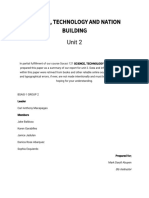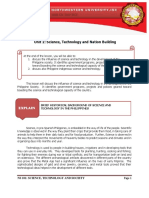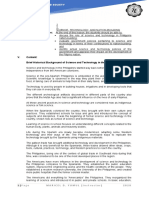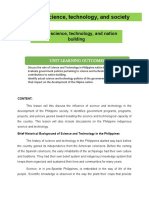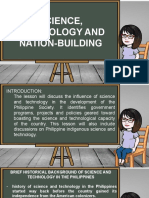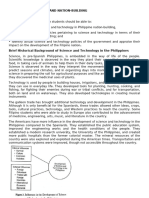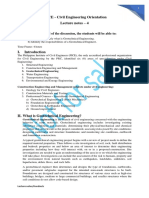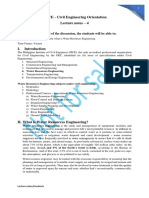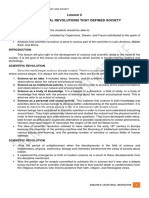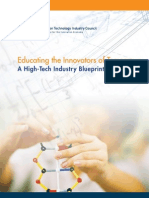Hand Out 3
Hand Out 3
Uploaded by
Mae TadaCopyright:
Available Formats
Hand Out 3
Hand Out 3
Uploaded by
Mae TadaOriginal Title
Copyright
Available Formats
Share this document
Did you find this document useful?
Is this content inappropriate?
Copyright:
Available Formats
Hand Out 3
Hand Out 3
Uploaded by
Mae TadaCopyright:
Available Formats
SCIENCE, TECHNOLOGY AND SOCIETY
Lesson 3
SCIENCE, TECHNOLOGY, AND NATION-BUILDING
LESSON OBJECTIVES:
At the end of this lesson, the students should be able to:
Discuss the role of science and technology in the Philippine nation-building;
Evaluate government policies pertaining to science and technology in terms of their contributions
to nation-building; and
Identify actual science and technology policies of the government and appraise their impact on
the development of the Filipino nation.
BRIEF HISTORICAL BACKGROUND OF SCIENCE AND TECHNOLOGY IN THE PHILIPPINES
The history of science and technology in the Philippines started way back before the country gained its
independence from the American colonizers.
PRE-SPANISH
- Science is embedded in the way of life of the people
- Technology is used by people in building houses, irrigations, and in developing tools that they
can use in everyday life.
- All these ancient practices in science and technology are considered now as indigenous science
and folk science.
SPANISH ERA
- They brought with them their own culture and practices.
- They established schools for boys and girls and introduced the concept of subjects and
disciplines.
- Learning of science in school focuses on understanding different concepts related to the human
body, plants, animals, and heavenly bodies.
- Life during this era slowly became modernized, adapting some Western technology and their
ways of life.
- The galleon trade has brought additional technology and development in the Philippines.
- Philippines was considered to be one of the most developed places in the region.
- Although the country is blessed with these development, the superstitious beliefs of the people
and the Catholic doctrines and practices during the Spanish era halted the growth of science in
the country.
AMERICAN
- More influence in the development of science and technology in the Philippines compared to
Spaniards.
- They established the public education system, improved the engineering works and the health
conditions of the people.
JENELYN N. SECRETARIA - INSTRUCTOR 1
SCIENCE, TECHNOLOGY AND SOCIETY
- Established modern research university, the University of the Philippines, and created more
public hospitals
- Transportation and communication systems were improved, though not accessible throughout
the country.
- In basic education, science education focuses in nature studies and science and sanitation, until
it became a subject formally known as “Science”.
- Researches were done to control malaria, cholera, and tuberculosis and other tropical diseases
WORLD WAR II
- Has destabilized the development of the country in many ways.
- Institutions and public facilities were turned into ashes, houses were burned, and many lives
were destroyed.
- The reparation money from Japan was also concentrated on building highways and providing
technological training and human resource development in the country
NEW REPUBLIC
- The whole nation has been focusing on using its limited resources in improving its science and
technological capabilities.
- Used of ODA to help the country improve its scientific productivity and technological capability.
Internal Influences
- Survival
- Culture
- Economic activities
Development of Science
and Technology in the
Philippines
External Influences
- Foreign Colonizers
- Trades with Foreign countries
- International Economic
demands
Figure 1. Influences in the Development of Science and Technology in the Philippines
Science and technology may have significant impact on the lives of the people and in the
development on the Philippine society. However, improving the quality of science education still
remains as a big challenge in the country. School science from basic education to graduate education
is improving slowly, and there are only few students enrolling in science and technology courses.
JENELYN N. SECRETARIA - INSTRUCTOR 2
SCIENCE, TECHNOLOGY AND SOCIETY
THINK ABOUT THESE QUESTIONS
1. What are the significant contributions of the Spaniards and Americans to the development of
science and technology in the Philippines?
2. What can you say about the state of science and technology during the Spanish and American
period?
3. How does school science shape science and technology in the country?
Activity
1. Read and reflect on the suggested reading.
Caoli, Olivia. “ A History of Science and Technology of the Philippines,” in Analysis of
Conditions for National Scientific and Technological Self-Reliance: The Philippine
Situation, Quezon City: University of the Philippines, 1986
Government Documents: 1 NEDA, National Development Agenda, Regional Agenda
GOVERNMENT POLICIES ON SCIENCE AND TECHNOLOGY
The Philippine government introduced and implemented several programs, projects, and
policies to boost the area of science and technology
Padilla-Concepcion (2015) reported that in 2015, in response to the ASEAN 2015 Agenda:
Department of Science and Technology (DOST), has sought the expertise of the National
Research Council of the Philippines (NRCP) to consult various section in the society to study how the
Philippines can prepare itself in meeting the ASEAN 2015 goals.
The NRCP clustered these policies into 4
1. Social Sciences, Humanities, Education, International Policies and Governance
• Integrating ASEAN awareness in basic education without adding to the curriculum
• Emphasizing teaching in the mother tongue
• Developing school infrastructure and providing for ICT broadband
• Local food security
2. Physics, Engineering and Industrial Research, Earth and Space Sciences, and
Mathematics
Emphasizing degrees, licenses, and employment opportunities
Outright grants for peer monitoring
Review of R.A. 9184
Harnessing science and technology as an independent mover of development
3. Medical, Chemical, and Pharmaceutical Sciences
Ensuring compliance of drug-manufacturing firms with ASEAN-harmonized standards by
full implementation of the Food and Drug Administration
Creating an education council dedicated to standardization of pharmaceutical services and
care
JENELYN N. SECRETARIA - INSTRUCTOR 3
SCIENCE, TECHNOLOGY AND SOCIETY
Empowering food and drug agencies to conduct evidence-based research as pool of
information
Allocating two percent of the GDP to research
Legislating a law supporting human genome projects
4. Biological Sciences, Agriculture, and Forestry
Protecting and conserving biodiversity by full implementation of existing laws
Use of biosafety and standard model by ASEAN countries
Promoting indigenous knowledge systems and indigenous people’s conservation
Formulation of common food and safety standards
PROGRAMS SUPPORTED BY THE PHILIPPINE GOVERNMENT THROUGH THE DOST
1. Providing funds for basic research and patents related to science and technology
2. Providing scholarships for undergraduate studies of the students in the field of science and
technology
3. Establishing more branches of the Philippine Science High School System for training young
Filipinos in the field of science and technology
4. Creating science and technology parks to encourage academe and industry partnerships
5. Balik scientist program
6. Developing science and technology parks in academic campuses
7. The establishment of the National Science Complex and the National Engineering Complex
within the UP Diliman campus.
The Philippine – American Academy of Science and Engineering (PAASE, 2008) identified
several capacity-building programs such as:
1. Establish the national centers of excellence
2. Manpower and institutional development programs
3. Establish of regional centers to support specific industries that will lead the country in different
research and development areas
4. Establish science and technology business centers
5. Strengthen science education at an early age
PHILIPPINE – CALIFORNIA ADVANCED RESEARCH INSTITUTE (PICARI)
- Allows several higher education institutions in the Philippines and some US-based laboratories
- This project is hoped to strengthen the STEM competitiveness of the country
AREAS AND FIELDS THAT THE COUNTRY IS LOOKING FORWARD TO EMBARK VARIOUS
RESEARCH AND PROJECTS:
1. Use of alternative and safe energy
2. Harnessing mineral resources
3. Finding cure for various diseases and illness
4. Climate change and global warming
5. Increasing food production
6. Preservation of natural resources
JENELYN N. SECRETARIA - INSTRUCTOR 4
SCIENCE, TECHNOLOGY AND SOCIETY
7. Coping with natural disasters and calamities
8. Infrastructure development
National Goals
SCIENCE AND TECHNOLOGY
International Treaty
- Policies
- Programs
Legal Frameworks - Projects
Social Needs, Issues, and
Problems
Figure 2. Development of Science and Technology Policies in the Philippines
As shown in the diagram, the development of policies in science and technology is shaped
or influenced by several variables: policies need to be aligned to national goals, consider international
commitments based on legal frameworks, and respond to various social needs, issues, and problems.
Science and technology policies ensure that the whole country and all people will experience progress
that science can bring. Policies are guides to direct all efforts to a goal of developing a scientifically
advanced country.
FAMOUS SCIENTISTS
People who devote their time studying science are called scientists. The following are some
famous scientists
1. Aristotle (384-322B.C.) was the first natural philosopher in the ancient world. He laid the
foundation for modern scientific thought.
2. Hildegard of Bingen (1098-1179) was a Benedictine nun. She was an outstanding scientist in
the Middle Ages. She wrote the medical books CAUSEA ET CURAE and PHYSICA which were
about diseases and their cures. These were considered the greatest scientific works of the
Middle Ages.
3. Nicolaus Copernicus (1473-1543) was a Polish scientist considered to be the founder of
modern astronomy. He advanced the theory that the sun is the center of the solar system and
that all of the planets revolve around the sun. This model of the solar system is now known as
the Copernican system.
4. Galileo Galilei (1564-1642) was a mathematician, physicist and astronomer. He proposed laws
that described the motions of falling bodies, projectiles and the pendulum. He studied heavenly
bodies using the telescope.
5. Johannes Kepler (1571-1630) was an astronomer who formulated the laws of planetary motion.
6. Isaac Newton (1642-1727) was an English mathematician, physicist and astronomer. He
formulated the laws of gravity and motion.
JENELYN N. SECRETARIA - INSTRUCTOR 5
SCIENCE, TECHNOLOGY AND SOCIETY
7. Charles Darwin (1809-1882) was an English scientist. His greatest work was The Origin of
Species where he discussed the theory of evolution and natural selection.
8. Marie Curie (1867-1934) is the first woman to receive the Nobel Prize in Physics. She was
awarded this prize for her discovery of radium in 1903. She discovered it with her husband Pierre
Curie and their colleague Henri Becquerel. She was also the first person to receive two Nobel
awards. She was awarded the Nobel Prize in Chemistry in 1911 for isolating pure radium.
9. Louis Pastuer (1822-1895) was a French scientist who became known for his work on biological
fermentation and decay. This led to his formulation of the germ theory of disease and the
discovery of sterilization of food through the use of heat.
10. Albert Einstein (1879-1955) proposed the theory of relativity. This theory debunked the
Newtonian belief that time was absolute. Surprisingly, he won the Nobel Prize for his work on
photoelectric effect and not the theory of relativity.
FAMOUS FILIPINOS IN THE FIELD OF SCIENCE
1. RAMON CABANOS BARBA – outstanding research on tissue culture in Philippine mangoes
- Inventor of horticulturist, induce more flowers in mango trees using
ethnel and potassium
2. JOSEPHINO CACAS COMISO – for his works on observing the characteristics of Antarctica by
using satellite images
3. JOSE BEJAR CRUZ JR. – known internationally in the field of electrical engineering; was
elected as officer of the famous Institute of Electrical and Electronic Engineering
4. LOURDES JUNSAY CRUZ – notable for her research on sea snail venom
- Therapeutic products for pain
5. FABIAN MILLAR DAYRIT – research on herbal medicine
6. RAFAEL DINEROS GUERO III – research on tilapia culture
7. ENRIQUE MAPUA OSTREA JR. – for inventing the meconium drug testing
- Drug testing for infants / new born
8. LILIAN FORMALEJO PATENA – for doing research on plant biotechnology
9. MARI-PANGANIBAN RUIZ – for being an outstanding educator and graph theorist
10. GREGORY LIGOT TANGONAN – for his research in the field of communications technology
- Inventor of analog messaging in sending messages using Fiber
Optics
11. CLARE R. BALTAZAR – the author of the book Philippine Insects. Her works on insects were
very useful for research on insect control. Her other scientific contributions include discovering
8 species and 1 subgenus of the insect Hymnoptera. She also discovered 108 new species of
Philippine parasitic wasps.
12. FILOMENA CAMPOS – known for her work on cotton in the Philippines. Her studies helped
develop a technology was developed within a short period – 3 years. She is also involved in
research on sunflowers as a possible source of edible oil and livestock feed (feed for cows,
goats, etc.)
13. LUZ OLIVEROS-BELARDO – a chemist and researcher. She studied essential oils that can be
collected from Philippine plants. These essential oils have many uses. They may be used as
flavoring, fragrance materials, and medicine and energy sources. She loved her work so much
JENELYN N. SECRETARIA - INSTRUCTOR 6
SCIENCE, TECHNOLOGY AND SOCIETY
that she spent 50 years of her life studying these essential oils. She was able to collect 33 new
Philippine essential oils and studied their physical and chemical properties.
14. EDUARDO A. QUISUMBING – is known for his studies in botany. He was one of the first
researchers to study Philippine medicinal plants and orchids. He wrote the book Medicinal Plants
of the Philippines, which is considered one of the first books on this area. He has also written
129 scientific articles.
15. BIENVENIDO O. JULIANO – studied the characteristics of grains and proteins and how these
affect the quality of rice. He showed that the amount of a substance called amylose determines
the quality of rice grains in Asia. The less of this substance that rice has, the less sticky it will be.
16. MELECIO S. MAGNO - is a physicist. He conducted studies on the absorption and fluorescence
spectroscopy of rare earth crystals, the effects of typhoons on atmospheric ozone, sky,
luminosity, atmospheric radiation and gravitation.
17. EMIL Q. JAVIER – is known for his very practical solutions to agricultural problems. Because
he knows that many farmers have very limited resources, he thought of practical methods of
improving crop production using cheap materials.
18. ALFREDO C. SANTOS – did research on the chemistry of the natural products and the
medicinal properties of Philippine plants. His work on herbs showed the properties of substances
in local plants. His concern for poor Filipinos who cannot afford expensive drugs spurred him to
conduct studies on local materials needed for the development of drugs.
19. GREGORIO T. VELASQUEZ – is known for his work in phycology. Phycology is the study of
algae. He devoted 30 years of his life to studying an algae called Myxophyceae. He was able to
produce 47 basic and 77 valuable scientific papers on the subject. Dr. Velasquez was also a
good educator. He taught and developed generations of good Filipino biologists, some of whom
became members of the National Academy of Science and Technology.
20. GREGORIO Y. ZARA – is noted for his contributions in engineering. His inventions are a source
of pride for us Filipinos. His inventions include the video phone, an alcohol-fueled airplane, a
solar energy absorber, an aircraft propeller that is made up entirely of wood, a wooden
microscope and semi-automatic propeller-making machine.
21. CESAR A. SALOMA – an internationally renowned physicist
- Professor of physics of NIP National Institute of Physics UP-D
22. EDGARDO GOMEZ – famous scientist in marine science
23. WILLIAM PADOLINA – chemist and president of National Academy of Science and Technology
(NAST) – Philippines.
24. ANGEL ALCALA – marine science. Known for his fieldwork to build sanctuaries and to promote
biodiversity in the aquatic ecosystems
Many of these Filipino scientists are products of good school science. It means they were
taught and inspired by great teachers. Their interests in science started to manifest during their
childhood years. Their natural environment ignited their curiosity to learn more about the natural
and physical environment. Schools and the laboratories where they studied and worked nurtured
this.
JENELYN N. SECRETARIA - INSTRUCTOR 7
SCIENCE, TECHNOLOGY AND SOCIETY
Individual Interests in
Science
SCHOOL SCIENCE
SCIENCE
LABORATORIES
Family
(TEACHERS AND
LEARNINIG
(REAL-LIFE CONTEXT)
ENVIRONMENT)
Natural Environment
FILIPINO SCIENTISTS
Figure 2. Factors that Influence the Development of Filipino Scientists
SUMMARY
This lesson discussed the influence of science and technology in the development of the
Philippines as a country. Even before the time of Spanish colonization in the Philippines, various people
and communities already practiced science. They invented tools and built structures, studies the
medicinal uses of plants, observed heavenly bodies to predict seasons and weather, and used
indigenous science in agriculture. These are considered indigenous science, which one of the
foundations of modern science.
The growth of science and its development as a field in the country is a hybrid of indigenous
and foreign ideas. Spain and the United States, being the former colonial masters of the country, played
an important role in building the foundation of science in the Philippines. To further strengthen the
science program in the Philippines, the government establishes various science programs, policies,
and projects.
Through the years, many Filipinos were able to establish themselves as scientists and science
educators in various scientific areas and fields. Invention and innovations were done by these Filipino
JENELYN N. SECRETARIA - INSTRUCTOR 8
SCIENCE, TECHNOLOGY AND SOCIETY
scientists. Finally, the demands of globalization, especially the ASEAN economic agenda, prompted
the Philippines to invest in science and technology programs and projects.
Watch and Reflect
- Great Filipino Inventions
THINK ABOUT THESE QUESTIONS
1. Identify several issued in the Philippines. What science and technology-related policies could be
developed and implemented to solve these issues?
2. What can you say about the implementation of some science and technology policies and
projects in the country?
3. What are the laws related to science and technology in the Philippines from the year 2000?
4. How are these laws implemented?
ACTIVITY
1. Identify several Filipino scientists.
2. Research on their contributions in the field of science.
3. Examine what made them pursue a career in science.
4. Present the result of your work in class.
JENELYN N. SECRETARIA - INSTRUCTOR 9
You might also like
- Section 4: Science, Technology, and Nation-BuildingDocument50 pagesSection 4: Science, Technology, and Nation-Buildingelizabeth bernales100% (5)
- Lesson 2 Science, Technology, and Nation-BuildingDocument5 pagesLesson 2 Science, Technology, and Nation-Buildingcamille guiaoNo ratings yet
- Science and Technology and The Nation-BuildingDocument7 pagesScience and Technology and The Nation-BuildingKclyn Remolona100% (3)
- Science Technology and SocietyDocument9 pagesScience Technology and Societyminejasminejas.17No ratings yet
- Sts Hand Outs 2Document12 pagesSts Hand Outs 2apriljirahmaelopezNo ratings yet
- Lesson 3 StsDocument4 pagesLesson 3 StsllaavvhiNo ratings yet
- Science Technology and Nation BuildingDocument4 pagesScience Technology and Nation BuildingCholophrex SamilinNo ratings yet
- Module 2 Sci, Tech & Nation BuildingDocument8 pagesModule 2 Sci, Tech & Nation Buildingsarah.sardonNo ratings yet
- CH 3 Lesson 1 - UpdatedDocument8 pagesCH 3 Lesson 1 - UpdatedFreda Buking DayogNo ratings yet
- CH 3 Lesson 1Document9 pagesCH 3 Lesson 1Judy Fe Bay-anNo ratings yet
- Science, Technology, and Nation-BuildingDocument6 pagesScience, Technology, and Nation-BuildingNiño Felipe IgnacioNo ratings yet
- Brief Historical Background of Science and Technology in The PhilippinesDocument27 pagesBrief Historical Background of Science and Technology in The PhilippinesIrish Dianne TulodNo ratings yet
- BSCRIM2E_STS_CHAPTER 1_LESSON 3_GROUP 1Document8 pagesBSCRIM2E_STS_CHAPTER 1_LESSON 3_GROUP 1Iris May DeocampoNo ratings yet
- Science and Technology and Nation BuildingDocument15 pagesScience and Technology and Nation BuildingNorodin A. RangaigNo ratings yet
- Lesson 3 For Science and TechnologyDocument3 pagesLesson 3 For Science and TechnologyAsh DeibNo ratings yet
- Module 1: Science, Technology, and SocietyDocument9 pagesModule 1: Science, Technology, and SocietyElla Mae LayarNo ratings yet
- CHAPTER - 3 - MSWORD - Docx Filename - UTF-8''CHAPTER 3 MSWORDDocument8 pagesCHAPTER - 3 - MSWORD - Docx Filename - UTF-8''CHAPTER 3 MSWORDCaurrine MonsaludNo ratings yet
- STS Module 2Document4 pagesSTS Module 2monesallenjayNo ratings yet
- Lesson 2: Science,, and Nation-BuildingDocument30 pagesLesson 2: Science,, and Nation-Buildingayessa may magayonNo ratings yet
- STSDocument37 pagesSTSIrenejoy Ramirez0% (1)
- Lesson 1.2 (STS)Document39 pagesLesson 1.2 (STS)Karylle AsturiasNo ratings yet
- StsDocument59 pagesStsPatriciacamille Austria100% (2)
- GE 7 ReportDocument31 pagesGE 7 ReportMark Anthony FergusonNo ratings yet
- Lesson 2 STSDocument28 pagesLesson 2 STSKayeAnne Mesina BibonNo ratings yet
- Science Technology and Nation Building PDFDocument37 pagesScience Technology and Nation Building PDFceanime x ML75% (4)
- ScitechDocument4 pagesScitechsooyaaaNo ratings yet
- Science Technology and SocietyDocument7 pagesScience Technology and SocietyGennelyn Lairise RiveraNo ratings yet
- Lesson 2: Science, Technology and Nation BuildingDocument29 pagesLesson 2: Science, Technology and Nation Building12 ABM 2A-BORRES, JEAN ROSENo ratings yet
- STS Midterm TopicsDocument14 pagesSTS Midterm TopicsWil LiamNo ratings yet
- STS 1 Module 3Document10 pagesSTS 1 Module 3Krizzle May CastroNo ratings yet
- Science, Technology and Nation-BuildingDocument27 pagesScience, Technology and Nation-BuildingchristinekategercingaganaoNo ratings yet
- STS Chapter 1 Lesson 2,3,4Document34 pagesSTS Chapter 1 Lesson 2,3,4Rey Mark Bandala67% (3)
- Group 1 STS ReportDocument37 pagesGroup 1 STS ReportGleanne Margaret GatpolintanNo ratings yet
- Lesson 3 Science and Technology in Nation BuildingDocument4 pagesLesson 3 Science and Technology in Nation BuildingRanniel EstrellaNo ratings yet
- Week 3 4Document60 pagesWeek 3 4h83052391No ratings yet
- Assignment 4 STS John Aldrich Rivera Bamm 1-DDocument2 pagesAssignment 4 STS John Aldrich Rivera Bamm 1-Djohnaldrichrivera09No ratings yet
- REPORT NI CLIENTDocument11 pagesREPORT NI CLIENTmusicpreskoNo ratings yet
- Orca Share Media1678341615211 7039474950047739897Document43 pagesOrca Share Media1678341615211 7039474950047739897Silvestre QuizoNo ratings yet
- Lesson 1.3. Science, Technology and Nation-BuildingDocument8 pagesLesson 1.3. Science, Technology and Nation-BuildingJames MichaelNo ratings yet
- Students Midterm Copy StudiesDocument37 pagesStudents Midterm Copy Studiespulisya09No ratings yet
- STS2 PrelimDocument10 pagesSTS2 PrelimCharis RebanalNo ratings yet
- STS G3 (1) - 030712Document72 pagesSTS G3 (1) - 030712Alvin Isulan PerezNo ratings yet
- STS ReviewerDocument8 pagesSTS ReviewerFrancineNo ratings yet
- sts reportingDocument9 pagessts reportingerickha galvezNo ratings yet
- Lesson 2 Science, Technology, and SocietyDocument7 pagesLesson 2 Science, Technology, and Societyeqwreq weqwNo ratings yet
- Sts Module 2Document8 pagesSts Module 2rodalyn malanaNo ratings yet
- Sir NarazoDocument38 pagesSir NarazoatendidomekaylaNo ratings yet
- STS Group 3Document6 pagesSTS Group 3rosetemira8No ratings yet
- Trixie Torres - ACTIVITY SHEET - LESSON 3 SCIENCE TECHNOLOGY AND NATION BUILDINGDocument7 pagesTrixie Torres - ACTIVITY SHEET - LESSON 3 SCIENCE TECHNOLOGY AND NATION BUILDINGTrixie Mendoza TorresNo ratings yet
- Chapter II Lesson 1 The Philippine Government Science and Technology AgendaDocument16 pagesChapter II Lesson 1 The Philippine Government Science and Technology AgendaalissonjaytabierosNo ratings yet
- Lesson 2 - STSDocument17 pagesLesson 2 - STS28christiandaveNo ratings yet
- Lesson 2 - Science, Technology, & Nation-BuildingDocument9 pagesLesson 2 - Science, Technology, & Nation-BuildingVijanes Beltrans100% (1)
- Government Policies PDFDocument3 pagesGovernment Policies PDFsatoukookieNo ratings yet
- MODULE-2-GE-7Document18 pagesMODULE-2-GE-7Rc WpNo ratings yet
- DispotrayasuyatmabaleDocument47 pagesDispotrayasuyatmabalekyla realinoNo ratings yet
- Scienceandtechnonolyandnationbuilding Lecturenotes 190113143211Document4 pagesScienceandtechnonolyandnationbuilding Lecturenotes 190113143211elladanicajNo ratings yet
- Brief Historical Background of Science and Technology in The PhilippinesDocument14 pagesBrief Historical Background of Science and Technology in The PhilippinesJomeljames Campaner PanganibanNo ratings yet
- File 819765613Document21 pagesFile 819765613tin tinNo ratings yet
- Science, Technology, and Nation-BuildingDocument5 pagesScience, Technology, and Nation-BuildingJewela Arquillano PlamaNo ratings yet
- ES CE - Civil Engineering Orientation Lecture Notes - 4Document10 pagesES CE - Civil Engineering Orientation Lecture Notes - 4Mae TadaNo ratings yet
- 2.0 TrigonometryDocument16 pages2.0 TrigonometryMae TadaNo ratings yet
- History of Social and Ballroom Dances Dance Positions: Bohol Island State UniversityDocument9 pagesHistory of Social and Ballroom Dances Dance Positions: Bohol Island State UniversityMae TadaNo ratings yet
- ES CE - Civil Engineering Orientation Lecture Notes - 6Document3 pagesES CE - Civil Engineering Orientation Lecture Notes - 6Mae TadaNo ratings yet
- ES CE - Civil Engineering Orientation Lecture Notes - 4Document4 pagesES CE - Civil Engineering Orientation Lecture Notes - 4Mae TadaNo ratings yet
- Hand Out 1Document21 pagesHand Out 1Mae TadaNo ratings yet
- Electrochemical Cells: BatteriesDocument4 pagesElectrochemical Cells: BatteriesMae TadaNo ratings yet
- ES CE - Civil Engineering Orientation Lecture Notes - 6Document3 pagesES CE - Civil Engineering Orientation Lecture Notes - 6Mae TadaNo ratings yet
- Hand Out 5Document3 pagesHand Out 5Mae TadaNo ratings yet
- 1 - Electrochemical Energy-1aDocument3 pages1 - Electrochemical Energy-1aMae TadaNo ratings yet
- 1 Energy-12Document4 pages1 Energy-12Mae TadaNo ratings yet
- Hand Out 4Document3 pagesHand Out 4Mae TadaNo ratings yet
- Lesson 2 Intellectual Revolutions That Defined SocietyDocument8 pagesLesson 2 Intellectual Revolutions That Defined SocietyMae Tada0% (1)
- ES CE - Civil Engineering Orientation Lecture Notes - 1: II. How To Become A Civil Engineer?Document4 pagesES CE - Civil Engineering Orientation Lecture Notes - 1: II. How To Become A Civil Engineer?Mae TadaNo ratings yet
- Draft - IESDocument21 pagesDraft - IESanalystNo ratings yet
- Samsung Service Marketing AssignmentDocument21 pagesSamsung Service Marketing Assignmentمحمد علي المطري75% (8)
- Decoding Stem Steam PDFDocument24 pagesDecoding Stem Steam PDFVLKNo ratings yet
- Alessandra Aprea Teaching Resume - Updated 1Document3 pagesAlessandra Aprea Teaching Resume - Updated 1api-354553787No ratings yet
- k-12 ThesisDocument6 pagesk-12 Thesisaouetoiig100% (2)
- Profed-109 - Rosario-Mark-John-Rey-R.-Module-3-ActivitiesDocument4 pagesProfed-109 - Rosario-Mark-John-Rey-R.-Module-3-ActivitiesJayacinthNo ratings yet
- Engineering Education in The Philippines: Donnalyn C. CabacesDocument5 pagesEngineering Education in The Philippines: Donnalyn C. CabacesJM PEREZNo ratings yet
- SSES-Letter-of-Intent-jen (AutoRecovered) (AutoRecovered)Document16 pagesSSES-Letter-of-Intent-jen (AutoRecovered) (AutoRecovered)ADELO CANON100% (1)
- Stem Training Survey Questionnaire Docx 1477920457417Document6 pagesStem Training Survey Questionnaire Docx 1477920457417api-336954866No ratings yet
- KHS Application v2Document6 pagesKHS Application v2ReemAlashhab81No ratings yet
- Community School AssessmentDocument10 pagesCommunity School AssessmentKehinde AdeyemiNo ratings yet
- Self-Efficacy and Academic Achievements in General Biology and General Mathematics of Grade 11 STEM Students at Catanduanes State University - Laboratory SchoolsDocument123 pagesSelf-Efficacy and Academic Achievements in General Biology and General Mathematics of Grade 11 STEM Students at Catanduanes State University - Laboratory SchoolsMerah Quel CondenoNo ratings yet
- 2.1 Extended Lesson Plan Introduction To Engineering Design ProcessDocument14 pages2.1 Extended Lesson Plan Introduction To Engineering Design Processkayavann5No ratings yet
- Week 8 ArticlesDocument4 pagesWeek 8 Articlesapi-309373770No ratings yet
- Grade 11Document2 pagesGrade 11Jay Cariel GastonesNo ratings yet
- 2012 Proceedings FinalDocument350 pages2012 Proceedings FinalConstantin DorinelNo ratings yet
- Impact of New Normal Education To Teachers and Students in Southern Palawan, PhilippinesDocument6 pagesImpact of New Normal Education To Teachers and Students in Southern Palawan, PhilippinesPsychology and Education: A Multidisciplinary JournalNo ratings yet
- Aldrian PreliminariesDocument8 pagesAldrian Preliminariesnosila_oz854No ratings yet
- 9185-Article Text-16413-1-10-20210620Document7 pages9185-Article Text-16413-1-10-20210620D1 PCNo ratings yet
- Educating The Innovators of TomorrowDocument97 pagesEducating The Innovators of Tomorrowpablo_moreNo ratings yet
- The Ontario Curriculum - Science - Grade 9 - De-Streamed Course - 2022Document55 pagesThe Ontario Curriculum - Science - Grade 9 - De-Streamed Course - 2022Aaa SssNo ratings yet
- Doing Creative ResearchDocument20 pagesDoing Creative Researchavishek1527No ratings yet
- Wilson Bruce ResumeDocument2 pagesWilson Bruce Resumeapi-251429676No ratings yet
- 1a - Abrenica - Research PaperDocument30 pages1a - Abrenica - Research PaperEdgar TorresNo ratings yet
- Factors Associated With Career Track Choice PDFDocument19 pagesFactors Associated With Career Track Choice PDFCindy MangayaNo ratings yet
- Guidelines and Criteria For Loans Issuance - Masters PHD 2024 2025Document8 pagesGuidelines and Criteria For Loans Issuance - Masters PHD 2024 2025rankingNo ratings yet
- Iem Jurutera Feb23Document48 pagesIem Jurutera Feb23Zero123No ratings yet
- 英文乙版第三冊課本Unit 5Document24 pages英文乙版第三冊課本Unit 5廖昀萱No ratings yet
- Impact of Conducive Classroom in The Academic PerformanceDocument17 pagesImpact of Conducive Classroom in The Academic PerformanceCherry MintNo ratings yet
- Buscaino Resume-Fall 2022Document2 pagesBuscaino Resume-Fall 2022api-676673800No ratings yet



